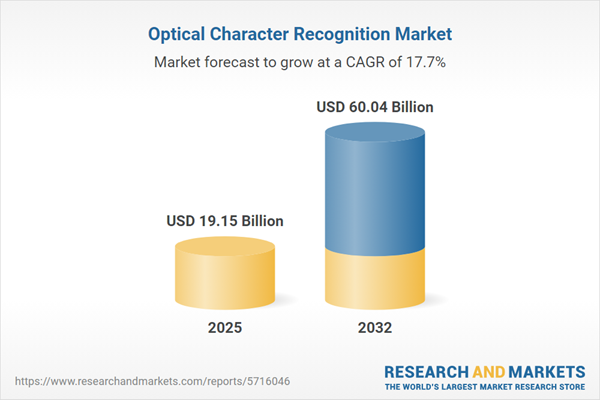Speak directly to the analyst to clarify any post sales queries you may have.
Optical Character Recognition (OCR) technology is rapidly transforming enterprise document management, supporting the evolution of compliance and workflow automation across industries. By integrating OCR, organizations position themselves to respond to regulatory demands and drive operational efficiency in global markets.
Market Snapshot: Optical Character Recognition Market
The global Optical Character Recognition market is currently valued at USD 16.26 billion, projected to reach USD 19.15 billion in the near term and USD 60.04 billion by 2032, supported by a compound annual growth rate (CAGR) of 17.73%. Market growth is fueled by escalating compliance demands, international expansion, and the need for advanced, secure, and cloud-native document management. AI-powered OCR advancements now deliver greater accuracy and faster processing, ensuring consistent, dependable data extraction and more agile, responsive workflows. Adoption is accelerating as organizations seek operational flexibility, regulatory alignment, and a more competitive stance in their respective sectors.
Scope & Segmentation
- Components: Advanced OCR platforms drive document capture, with high-precision recognition engines and hardware accelerators delivering fast, detailed data processing. Managed services support automation across large-scale and complex workflows.
- Deployment Types: Cloud-based solutions offer rapid scalability and seamless integration, addressing organizational needs for adaptability. On-premise deployments serve scenarios demanding strict data controls, confidentiality, or compatibility with legacy IT infrastructure.
- Applications: Major use cases span automated document processing, streamlined financial transaction management, accelerated onboarding, and secure identity verification. These applications support risk reduction and improved compliance, while minimizing manual effort and errors.
- End User Industries: Core sectors adopting OCR include finance, government, healthcare, IT, telecommunications, retail, ecommerce, and manufacturing. Integration in these industries helps automate core operations, streamline compliance, and improve productivity.
- Organization Size: Large enterprises deploy OCR platforms for scalability and resource efficiency, while small and midsize businesses benefit from tailored, cost-effective automation solutions that promote operational agility.
- Regional Coverage: Notable adoption spans the Americas, Europe, Middle East, Africa, and Asia-Pacific. Focused business and regulatory drivers are evident in the United States, Canada, Mexico, Brazil, China, India, Japan, and Australia, where market maturity and compliance requirements shape growth trajectories.
- Key Companies: The competitive landscape features Google LLC, Microsoft Corporation, Adobe Inc., Amazon Web Services, ABBYY USA Software House Inc., IBM Corporation, Kofax Inc., Nuance Communications, Canon Inc., Rossum Ltd., NVIDIA Corporation, OpenText Corporation, LEAD Technologies, viso.ai, and Parascript, LLC.
Key Takeaways
- AI-enhanced OCR solutions drive higher data accuracy and automate complex workflows, improving both compliance and data governance at scale.
- Wider OCR adoption decreases manual document handling, reduces operational bottlenecks, and strengthens regulatory reporting and client onboarding procedures.
- Cloud-based deployments provide organizations with on-demand scalability, seamless updates, and enhanced coordination among distributed or hybrid teams worldwide.
- Strategic integration of leading vendors’ software, hardware, and managed services results in unified, enterprise-level solutions and more efficient company-wide adoption.
- Configurable OCR technologies enable reliable multilingual and cross-border operations, ensuring consistent regulatory adherence across diverse markets.
Tariff Impact: Navigating New Regulatory Dynamics
Forthcoming US tariffs anticipated in 2025 are influencing enterprise OCR hardware procurement strategies. Organizations are increasingly evaluating local or nearshore sourcing alternatives to offset global supply chain risks and manage costs. Concurrently, modular and software-based OCR models are gaining traction, helping firms maintain business resilience and reduce exposure to hardware delivery delays.
Methodology & Data Sources
This report draws upon direct interviews with senior executives, practitioner insights, and case studies, complemented by an extensive literature review and up-to-date regulatory analysis. The methodology ensures alignment with shifting enterprise priorities and addresses real-world challenges in OCR adoption.
Why This Report Matters
- Enables leadership to strategically align OCR investments with ongoing digital transformation and long-term business visions through actionable market intelligence.
- Prepares organizations to adapt to shifting compliance requirements and potential supply chain or tariff impacts with robust, actionable guidance.
- Equips decision-makers to reduce risk exposure and capitalize on new opportunities within document-intensive business processes and operations.
Conclusion
This analysis delivers practical insights, empowering senior leaders to select suitable OCR technologies and reinforce compliance strategies for resilient, future-oriented information management.
Additional Product Information:
- Purchase of this report includes 1 year online access with quarterly updates.
- This report can be updated on request. Please contact our Customer Experience team using the Ask a Question widget on our website.
Table of Contents
3. Executive Summary
4. Market Overview
7. Cumulative Impact of Artificial Intelligence 2025
Companies Mentioned
The companies profiled in this Optical Character Recognition market report include:- Google LLC by Alphabet Inc.
- Microsoft Corporation
- Adobe Inc.
- Amazon Web Services, Inc.
- ABBYY USA Software House Inc.
- IBM Corporation
- Kofax Inc.
- Nuance Communications, Inc.
- Canon Inc.
- Rossum Ltd.
- NVIDIA Corporation
- OpenText Corporation
- LEAD Technologies, Inc.
- viso.ai
- Parascript, LLC
Table Information
| Report Attribute | Details |
|---|---|
| No. of Pages | 187 |
| Published | October 2025 |
| Forecast Period | 2025 - 2032 |
| Estimated Market Value ( USD | $ 19.15 Billion |
| Forecasted Market Value ( USD | $ 60.04 Billion |
| Compound Annual Growth Rate | 17.7% |
| Regions Covered | Global |
| No. of Companies Mentioned | 16 |









